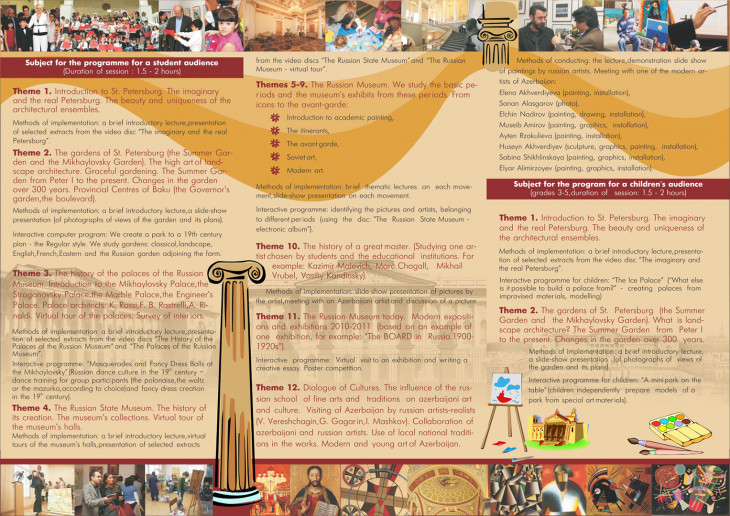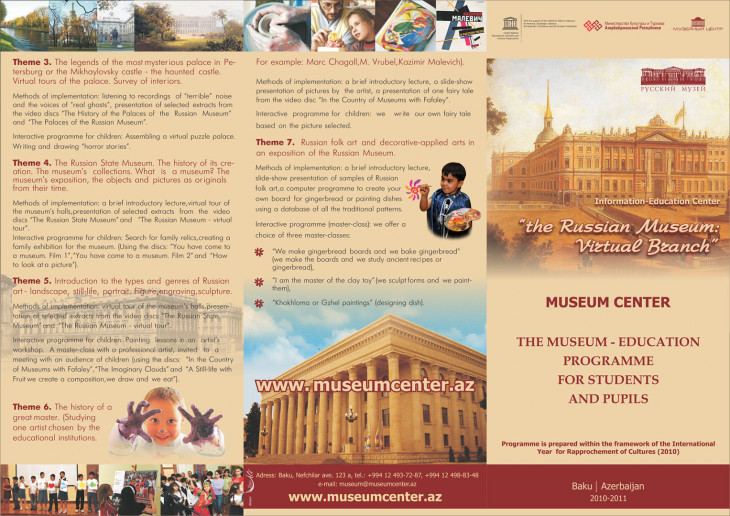The museum-educational programmes of the Information-education centre “The Russian museum: Virtual branch” in The Museum Center
The suggested educational program particularly aimed:
- To increase levels of knowledge and to inform about cultural diversity;
- To strengthen language policy in the development of intercultural exchange;
- To provide free access to knowledge and information about Russian culture for users, in three languages (Azerbaijani, Russian, English);
- To familiarise visitors (the Azerbaijani audience) with Russian culture, using the example of the Russian Museum;
- To meet spiritual-cognitive needs;
- To enhance emotional development and aesthetic susceptibility;
- To develop motivation (aesthetic, ethical and cognitive motivation);
- To develop communicative skills;
- To enlarge visitors’ “environments”;
- To develop a museum culture and visual literacy;
- To offer professional enlightenment and professional counselling to students and children.
Preliminary subjects for the programme for a student audience
(each session approximately 1.5 - 2 hours)
Theme 1. Introduction to St. Petersburg. The imaginary and the real Petersburg. The beauty and uniqueness of the architectural ensemble.
Methods of implementation: a brief introductory lecture, presentation of selected extracts from the video disc “The imaginary and the real Petersburg”.
Theme 2. The gardens of St. Petersburg (the Summer Garden and the Mikhaylovsky Garden). The high art of landscape architecture. Graceful gardening. The Summer Garden from Peter I to the present. Changes in the garden over 300 years. Provincial Centres of Baku (the Governor, the boulevard).
Methods of implementation: a brief introductory lecture, a slide-show presentation (of photographs of views of the garden and its plans).
Interactive computer program: we create a park to a 19th century plan - the Regular style.
We study gardens: classical, landscape, English, French, Eastern and the Russian garden adjoining the farm.
Theme 3. The history of the palaces of the Russian Museum. Introduction to the Mikhaylovsky Palace, the Stroganovsky Palace, the Marble Palace, the Engineer’s Palace. Palace architects: K. Rossi, F. B. Rastrelli, A. Rinaldi. Virtual tour of the palaces. Survey of interiors.
Methods of implementation: a brief introductory lecture, presentation of selected extracts from the video discs “The History of the Palaces of the Russian Museum” and “The Palaces of the Russian Museum”.
Interactive program: “Masquerades and Fancy Dress Balls at the Mikhaylovsky.” (Russian dance culture in the 19th century – dance training for group participants (the polonaise, the waltz or the mazurka, according to choice) and fancy dress creation in the 19th century).
Theme 4. The Russian State Museum. The history of its creation. The museum’s collections. Virtual tour of the museum’s halls.
Methods of implementation: a brief introductory lecture, virtual tours of the museum’s halls, presentation of selected extracts from the video discs “The Russian State Museum” and “The Russian Museum - virtual tour”.
Themes 5-9. The Russian Museum. We study the basic periods and the museum’s exhibits from these periods. From icons to the avant-garde:
- introduction to academic painting;- the Itinerants;- the Avant garde;- Soviet art;- Modern art.
Methods of implementation: brief thematic lectures on each movement, slide-show presentations (5) on each movement.
Interactive program: identifying the pictures and artists belonging to different periods (using the disc: "The Russian State Museum - electronic album").
Theme 10. The history of a great master. (Studying one artist chosen by students and the educational institution. For example: Kazimir Malevich, Marc Chagall, M. Vrubel, W. Kandinsky).
Methods of implementation: slide-show presentation of pictures by the artist, meeting with an Azerbaijani artist (attitude towards creativity), discussion of a picture.
Theme 11. The Russian Museum today. Modern expositions and exhibitions 2010-2011. (based on an example of one exhibition, for example: the BOARD in Russia, 1900-1920s).
Interactive program: Virtual visit to an exhibition and writing a creative essay. Poster competition.
Theme 12. Dialogue of Cultures. The influence of the russian school of fine arts and traditions on azerbaijani art and culture. Visiting of Azerbaijan by russian artists-realists (V. Vereshchagin, G. Gagarin, I. Mashkov). Collaboration of azerbaijani and russian artists. Use of local national traditions in the works. Modern and young art of Azerbaijan.
Methods of conducting: the lecture, demonstration slide show of paintings by russian artists. Meeting with one of the modern artists of Azerbaijan. (Elnur Babayev (photography, painting, graphics), Elena Akhverdiyeva (painting, installation), Sanan Alasgarov (photo), Elchin Nadirov (painting, drawing, installation), Museib Amirov (painting, graphics, installation), Ayten Rzakulieva (painting, installation), Ujal Akhverdiyev (painting), Zakir Huseynov (painting, graphics, installation), Huseyn Akhverdiyev (sculpture, graphics, painting, installation), Sabina Shikhlinskaya (painting, graphics, installation), Elyar Alimirzoyev (painting, graphics, installation).

Preliminary subjects for the programme for a children's audience
(grades 3-5, each session approximately 1.5 - 2 hours)
Theme 1. Introduction to St. Petersburg. The imaginary and the real Petersburg. The beauty and uniqueness of the architectural ensemble.
Methods of implementation: a brief introductory lecture, presentation of selected extracts from the video disc “The imaginary and the real Petersburg”.
Interactive program for children: “The Ice Palace (history)” (“What else is it possible to build a palace from?” - creating palaces from improvised materials, modelling).
Theme 2. The gardens of St. Petersburg (the Summer Garden and the Mikhaylovsky Garden). What is landscape architecture? The Summer Garden from Peter I to the present. Changes in the garden over 300 years.
Methods of implementation: a brief introductory lecture, a slide-show presentation (of photographs of views of the garden and its plans).
Interactive program for children: “A minipark on the table” (Children independently prepare models of a park from special art materials).
Theme 3. The legends of the most mysterious palace in Petersburg, or, the Mikhaylovsky castle - the haunted castle. Virtual tours of the palace. Survey of interiors.
Methods of implementation: listening to recordings of “terrible” noise and the voices of “real ghosts”, presentation of selected extracts from the video discs “The History of the Palaces of the Russian Museum” and “the Palaces of the Russian Museum”.
Interactive program for children: Assembling a virtual puzzle palace. Writing and drawing “Horror stories”.
Theme 4. The Russian State Museum. The history of its creation. The museum’s collections. What is a museum? The museum’s exposition and the objects and pictures as originals from their time.
Methods of implementation: a brief introductory lecture, virtual tour of the museum’s halls, presentation of selected extracts from the video discs “The Russian State Museum” and “The Russian Museum - virtual tour”.
Interactive program for children: Search for family relics, creating a family exhibition for the museum. (Using the discs: “You have come to a museum. Film 1”, “You have come to a museum. Film 2” and “How to look at a picture”).
Theme 5. Introduction to the types and genres of Russian art - landscape, still-life, portrait, figure, engraving, sculpture.
Methods of implementation: virtual tour of the museum’s halls, presentation of selected extracts from the video discs “The Russian State Museum” and “The Russian Museum - virtual tour”.
Interactive program for children: Painting lessons in an artist's workshop. A master-class with a professional artist invited to a meeting with an audience of children (using the discs: “In the Country of Museums with Fafaley”, “The Imaginary Clouds” and “A Still-life with Fruit - we create a composition, we draw and we eat”).
Theme 6. The history of a great master. (Studying one artist chosen by the educational institution. For example: Marc Chagall, M. Vrubel, Malevich).
Methods of implementation: a brief introductory lecture, a slide-show presentation of pictures by the artist, a presentation of one fairy tale from the disc “In the Country of Museums with Fafaley”.
Interactive program for children: we write our own fairy tale based on the picture selected.
Theme 7. Russian folk art and decorative-applied arts in an exposition of the Russian Museum.
Methods of implementation: a brief introductory lecture, slide-show presentation of samples of Russian folk art, a computer program to create your own board for gingerbread or painting dishes using a database of all the traditional patterns.
Interactive program (master-class): we offer a choice of three master-classes.
- “We make gingerbread boards and we bake gingerbread” (we make the boards and we study ancient recipes for gingerbread),
- “I am the master of the clay toy” (we sculpt forms and we paint them),
- “Khokhloma or Gzhel paintings (designing a dish).
